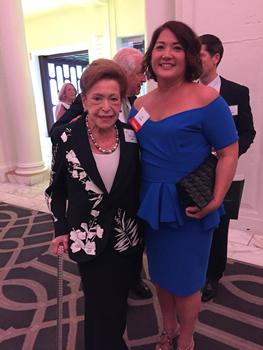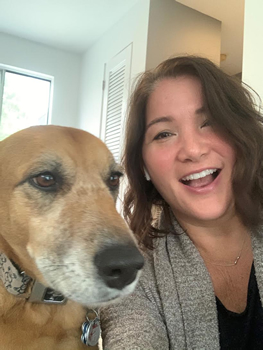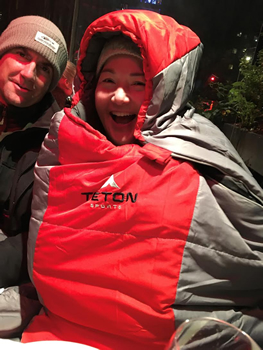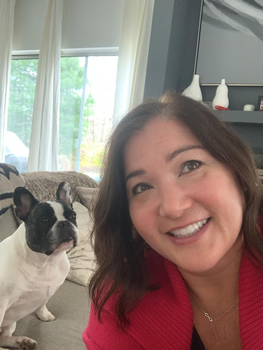A Memorable Thriller About Amnesia
 By Karen Hugg
By Karen Hugg
Though she worked in the criminal justice system for years, Alafair Burke has never come across a real-life case of amnesia. Or at least she doesn’t remember if she did, she says with a wry smile. This bestselling author of more than 20 novels, including Judgment Calls, The Ex (an Edgar Award nominee) and the Under Suspicion series with Mary Higgins Clark, knows about “the fragility of memory” since, as she says, “witnesses never remember a situation the same way.”
Burke grew up in Wichita, Kansas, reading sweet mysteries like The Mixed-Up Files of Mrs. Basil E. Frankweiler during a time when the infamous BTK serial killer was on the loose. This formed an early fascination with crime and the psychology of people’s reaction to it. She went on to build a career as an attorney, spending several years working as Portland’s deputy district attorney and at a private law firm before moving to New York to teach at Hofstra University.
This idea of a disconnection from the past forms the heart of her new novel, FIND ME. It focuses on the disappearance of a young woman named Hope Miller. Years ago, she was found near a crashed car without identification, unable to remember her given name or personal history, by Lindsay Kelly, a Manhattan defense lawyer who now wants to find her friend. But the only lead is a trace of blood that matches evidence in the case of a serial killer in Kansas. So Lindsay contacts detective Ellie Hatcher, a character familiar to Burke’s readers, for help in finding out whether her friend is still alive and in hiding for a reason related to her mysterious background, or if she’s been murdered and is gone for good.
Burke talked with The Big Thrill about the origins of FIND ME, her own earliest memories of crime, her upbringing in Kansas, and how she makes decisions, or rather discoveries, during her writing process.
What was the first crime news story you remember?

My family moved to Wichita in 1978, just as the local police department there was playing—and replaying—the tape-recorded voice of a serial killer who called himself BTK. My parents had relocated us from southern Florida with expectations of a quiet, simple Midwestern town. In many ways, we had that in Wichita, but always under the shadow of a real-life boogeyman.
I remember playing hooky with my best friend in the fifth grade, only to regret it when someone knocked on the door, surely for some innocuous purpose. After hiding behind the couch for 30 minutes, still certain it was BTK coming to get us, we turned ourselves in to kind old Mrs. Farrell next door in exchange for her guardianship until our parents returned. I remember the night my siblings called 911 because of the slow movement of a French door. Police stormed the house to find a window left open in the study.
Everyone who grew up in Wichita during that era was in the habit of checking their phone lines regularly (he would cut them) and locking the basement door (they thought he entered through the basement, but this turned out not to be true). What made this man so terrifying was that we knew so little about him and yet so much—Bind, Torture, Kill. We knew he walked in and out of homes in the middle of the day, cut the phone cords, and would calmly call 911 when it was all over. And we knew he could be anyone.
Some of your past novels, including Judgment Calls and Angel’s Tip, were inspired by real-life crimes. You mentioned FIND ME was as well. What was its real-life situation?

FIND ME centers on the sudden disappearance of a woman named Hope Miller—at least, that’s the name she assumed 15 years earlier when she was found in the rain, thrown from an overturned SUV, with no idea who she was or how she got to a small town in New Jersey with no money and no identification.
I have followed a few different cases of long-term amnesia over the years. Perhaps the most well-known is Benjaman Kyle, who was found naked and injured and without any identification behind a fast-food restaurant outside Savannah, Georgia, in 2004. It was 2015 before his real identity was found, and in the intervening years he was often homeless and unable to work because he didn’t remember his Social Security number.
If I had to pick one case that got the wheels turning toward FIND ME, it’s a woman who has had multiple fugue states, disappearing for weeks at a time. It’s not the same phenomenon, but it got me thinking about the idea of someone who started a new life like Benjaman Kyle did, only to go missing again. I also wondered what it would be like to be a close friend to that person.
You’ve also deftly explored women’s relationships in your novels. In FIND ME, there’s a closeness between Lindsay and Hope. Can you talk about how those two characters formed in your mind?
I started FIND ME a long time ago, before I wrote my previous novel The Better Sister, in fact. The character serving the role of chief-friend-investigator was a victim’s advocate who had gotten to know Hope through the police department. Meanwhile, Hope had another friend named Lindsay who was the police chief’s daughter. I got pretty far into the book before I realized that Lindsay was the person who would search the hardest for Hope, never doubting her and risking everything. The epigraph of FIND ME is that great line from Thelma and Louise: “Louise, no matter what happens, I’m glad I came with you.” Hope is Lindsay’s Louise—her Ride or Die.

In light of that, there’s an interesting small twist at the end concerning Hope. Do you plan out the revelations, or do they organically come about in the writing process?
That one’s hard to answer on the nose without getting into spoilers. Some revelations are known to me from the very beginning. The really big surprise in my book The Wife, for example, was the impetus for the entire novel. Some of the reveals in FIND ME were there from the very beginning, but a couple even caught me by surprise. I love it when that happens. And when it does, it’s because the characters grew and shifted as I was writing and ended up leading the way to an organic realization.
FIND ME has a complex, surprising plot narrated from various characters’ points of view. How do you decide whose perspective tells what parts of the story?
I’m laughing as I answer this, because the truth is that I don’t decide! I often change points of view during a re-write after the first draft. I love a good shift in point of view. My first novels were almost entirely in the first person, and then I began to write in the third person to enable multiple points of view.
Co-authoring with Mary Higgins Clark, I saw how well she always used the changed voice and perspective to ramp up suspense. Not to show a magician’s trick, but sometimes you want an outside observer to narrate a scene from a relatively neutral perspective for the reader. But often you want the reader to know they’re getting only one person’s look at the story. Making that choice is pretty fun.
You’re the daughter of the well-known novelist James Lee Burke. But your mother was a librarian and also a book lover. What influence did she have on you as a storyteller?
Reading was a constant. Every Saturday, my mother took me downtown to watch a children’s dollar matinee, scour the clearance racks in the Macy’s basement, and spend the rest of the day curating a new stack of books at the Wichita public library.

Along those lines, the Samantha Kincaid character doesn’t have a particularly dark, hardboiled background. Was her background inspired by your own apparently loving upbringing?
I spent five years in the same office as Samantha Kincaid, so there is overlap between our careers, certainly. Of the main characters I’ve created, she’s probably most reflective of my own sensibilities. However, she’s much more brazen and confrontational than I am. She’s also funnier, taller, thinner, and more neurotic and could beat me in a race without breaking a sweat. I suppose she’s a better and exaggerated version of me. We also both have a dad who cracks himself up leaving phone messages.
You’ve said that through your writing, teaching, and all else, “It’s all crime, all the time” for you. What is it about the nature of a crime that interests you?
My love of mystery stories and my fascination with crime and the legal system were born out of my childhood in Wichita. Through crime, we see the entire range of the human experience and reactions to it. I also love a good puzzle, and a well-executed crime novel plot, to me, is the best kind of puzzle.
Do you think there’s a parallel between being a skilled lawyer who can effectively tell the story of a crime to a jury and a writer who can effectively tell the story of a crime to an audience?
Lawyers, like authors, tell stories. If you think of a trial, the attorney not only has to tell a story that the jury finds compelling, but it is told in a certain very unnatural structure—not from beginning, to middle, to end, but through the words of one witness at a time. That forces you to break down a story into its raw components and be able to put it back together in a strategic and dramatic way.
You’re the president of the Mystery Writers of America, you serve on the Authors Guild Foundation Board, and you teach law at Hofstra University. How do you find time to do all that you do?
I don’t have children. That’s a serious answer, by the way. I don’t know how my friends with kids manage to get anything done. I love my nieces and nephews and my friends’ children, but I don’t spend hours a week helping them with homework or taking them to soccer practice.
One of your dogs’ names is Double. What’s the origin of that cute name?
Our first dog was a white and black French bulldog named The Duffer, which is a golf term for a bad golfer. When we got a second dog, he ended up being yet another white and black Frenchie. We named him Double, as in Double Bogey, but also like a little double of our OG Duffer. He has my husband’s last name, making him Double Simpson. The vet thought that was his actual name, like some kind of patented wrestle move—“And he’s locked in a Double Simpson!”
His little (but much larger) sister is Frannie, whom we found beach roaming on Anguilla. She’s named after Frangipani, a hotel on the prettiest beach in the world. Double has had cameos in a Michael Connelly novel and a short story by Karin Slaughter and Michael Koryta. Frannie’s still waiting for someone to make her famous.
What book, if any, did you give as a holiday gift this year? What have you been reading that you like?
I just finished The Dark Hours by Michael Connelly, and Lisa Scottoline’s forthcoming What Happened to the Bennetts, which is a total scorcher. Two of my favorite novels this year were The Collective by Alison Gaylin and Last Girl Ghosted by Lisa Unger.
What are you focusing on in 2022?
Well, first and foremost, the launch of FIND ME. This is my first solo novel in more than two years, and I’m thrilled to be back out there again. I’m also finishing up a sequel to the iconic novel Where Are the Children, a project I’m so honored that my co-author Mary Higgins Clark entrusted to me to complete. Plus, my next book after that. There’s always something!
